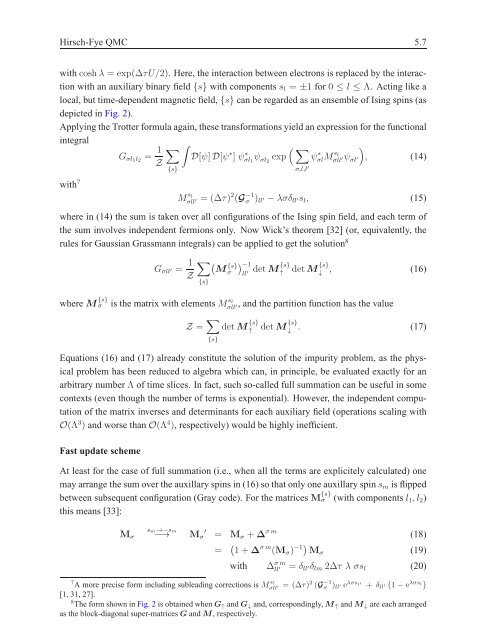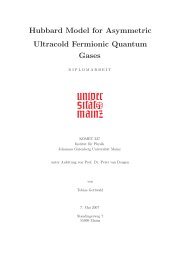5 Hirsch-Fye quantum Monte Carlo method for ... - komet 337
5 Hirsch-Fye quantum Monte Carlo method for ... - komet 337
5 Hirsch-Fye quantum Monte Carlo method for ... - komet 337
Create successful ePaper yourself
Turn your PDF publications into a flip-book with our unique Google optimized e-Paper software.
<strong>Hirsch</strong>-<strong>Fye</strong> QMC 5.7<br />
withcoshλ = exp(∆τU/2). Here, the interaction between electrons is replaced by the interaction<br />
with an auxiliary binary field {s} with components sl = ±1 <strong>for</strong> 0 ≤ l ≤ Λ. Acting like a<br />
local, but time-dependent magnetic field, {s} can be regarded as an ensemble of Ising spins (as<br />
depicted in Fig. 2).<br />
Applying the Trotter <strong>for</strong>mula again, these trans<strong>for</strong>mations yield an expression <strong>for</strong> the functional<br />
integral<br />
with 7<br />
Gσl1l2 = 1<br />
Z<br />
�<br />
�<br />
{s}<br />
D[ψ]D[ψ ∗ ] ψ ∗ σl1 ψ σl2 exp<br />
��<br />
σ,l,l ′<br />
ψ ∗ σlM sl<br />
σll ′ψ<br />
�<br />
σl ′ , (14)<br />
M sl<br />
σll ′ = (∆τ) 2 (G −1<br />
σ )ll ′ −λσδll ′sl, (15)<br />
where in (14) the sum is taken over all configurations of the Ising spin field, and each term of<br />
the sum involves independent fermions only. Now Wick’s theorem [32] (or, equivalently, the<br />
rules <strong>for</strong> Gaussian Grassmann integrals) can be applied to get the solution 8<br />
1<br />
Gσll ′ =<br />
Z<br />
�<br />
{s}<br />
� M {s}<br />
σ<br />
� −1<br />
ll ′ detM {s}<br />
↑ detM{s}<br />
↓ , (16)<br />
whereM {s}<br />
σ is the matrix with elementsM sl<br />
σll ′, and the partition function has the value<br />
Z = �<br />
{s}<br />
detM {s}<br />
↑ detM{s}<br />
↓ . (17)<br />
Equations (16) and (17) already constitute the solution of the impurity problem, as the physical<br />
problem has been reduced to algebra which can, in principle, be evaluated exactly <strong>for</strong> an<br />
arbitrary numberΛ of time slices. In fact, such so-called full summation can be useful in some<br />
contexts (even though the number of terms is exponential). However, the independent computation<br />
of the matrix inverses and determinants <strong>for</strong> each auxiliary field (operations scaling with<br />
O(Λ 3 ) and worse thanO(Λ 4 ), respectively) would be highly inefficient.<br />
Fast update scheme<br />
At least <strong>for</strong> the case of full summation (i.e., when all the terms are explicitely calculated) one<br />
may arrange the sum over the auxillary spins in (16) so that only one auxillary spinsm is flipped<br />
between subsequent configuration (Gray code). For the matrices M {s}<br />
σ (with componentsl1,l2)<br />
this means [33]:<br />
Mσ<br />
sm→−sm<br />
−→ Mσ ′ = Mσ +∆ σm<br />
= � 1+∆ σm (Mσ) −1� Mσ<br />
(18)<br />
(19)<br />
with ∆ σm<br />
ll ′ = δll ′δlm 2∆τ λ σsl (20)<br />
� �<br />
λσsl 1 − e<br />
7 sl<br />
A more precise <strong>for</strong>m including subleading corrections is Mσll ′ = (∆τ)2 (G −1<br />
σ )ll ′ eλσsl ′ + δll ′<br />
[1, 31, 27].<br />
8 The <strong>for</strong>m shown in Fig. 2 is obtained whenG↑ andG↓ and, correspondingly,M↑ andM↓ are each arranged<br />
as the block-diagonal super-matricesGandM, respectively.













